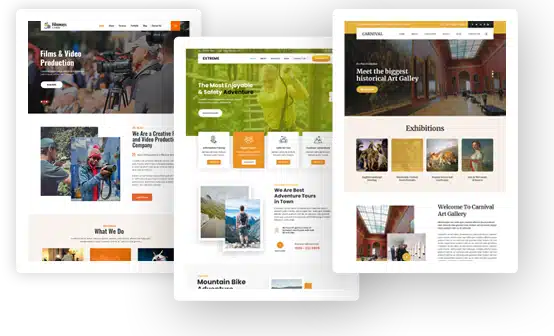The Complete SEO Audit Guide For WordPress Sites

If you run a WordPress site, you probably know SEO matters. But knowing and actually keeping your site optimized are two very different things. WordPress is flexible and user-friendly, but themes, plugins, and updates can quietly create issues that hurt your rankings. That’s why you should make an SEO audit a habit and consider leveraging technical SEO services to keep your site optimized.
In simple terms, this is a thorough audit of your site to ensure Google can find your pages, your content is solid, and your visitors have a smooth experience. This guide will walk you through everything you need to audit so you can spot problems before they cost you traffic.
Why a WordPress SEO Audit Matters
If you think WordPress handles SEO automatically, you’re only half right. Out of the box, it’s solid, but themes, plugins, and updates can quietly introduce problems.
Take the example of the Yoast SEO plugin. This is by far the most popular tool for meta tags, sitemaps, and schema. However, misconfiguring it by, say, incorrectly applying “noindex” settings or canonical URLs can make whole sections of your site disappear from Google.
When you run an SEO audit regularly, you get to see what issues are out there to hurt your search performance. Focus on whether Google can find your pages, your content makes sense, and whether your site isn’t slowing down visitors. A good practice is to run mini-audits every month or quarterly, and a full audit once a year.
Working with professionals such as those at https://smartlydone.com/ or any others you’re familiar with can go a long way. These digital marketing experts will spend their time getting your SEO posture right while you focus on the business processes that matter most. Take your time to research and go with the best fit for your needs.
Pre-Audit Setup
Before you get knee-deep into your audit, you need a clean starting point. Here’s where you start:
- Use a plugin like Jetpack Backup to keep a copy of your site in case something goes wrong and you need to revert.
- Make sure you can log into WordPress, your hosting panel, and your CDN if you’re using one.
- Connect Google Search Console and Google Analytics so you can have a clear picture of what’s working and what isn’t.
- Install an SEO plugin, such as Yoast, Rank Math, or SEOPress, to audit your meta titles, descriptions, and sitemaps.
With these tools in place, you’re ready to get into the audit.
Technical SEO Checks
Here’s what to focus on:
- Site indexing: Make sure Google can actually see your pages. Check the coverage report in Search Console and confirm your canonical versions are correct (https vs http, www vs non-www).
- Site speed: Slow pages can kill rankings and frustrate visitors. Test with PageSpeed Insights or GTmetrix. Compress images, enable caching, and consider a lightweight theme.
- Mobile friendliness: Most traffic comes from mobile. Run Google’s Mobile-Friendly Test and make sure your theme responds to all screen sizes.
- Structured data: Adding Schema helps search engines understand your content. Use a plugin or built-in theme options, then test with Google’s Rich Results tool.
- Broken links and redirects: Use Screaming Frog or Broken Link Checker to find dead links and set up proper 301 redirects.
Fix these first, and your site is in a healthy state for search engines to crawl.
On-Page SEO Checks
Here’s what to prioritize:
-
Title Tags and Meta Descriptions
Make each one unique, keyword-aligned, and clear. Keep titles under 60 characters, meta descriptions under 160. Why: These snippets are what show up in search results. Better titles and descriptions improve click-through rates and tell Google exactly what a page is about.
-
Headings (H1, H2, H3)
Have one H1 per page. Subheadings should make the content scannable and logically structured. A clear heading structure helps visitors skim easily and gives search engines a roadmap of your content’s hierarchy.
-
Content Quality
Google favors helpful content. Make it complete, easy to read, and up to date. Avoid stuffing keywords; that is, write for humans first. Fresh, valuable content earns trust, keeps visitors on the page, and satisfies Google’s quality guidelines (EEAT).
-
Images
Use descriptive filenames, alt text, and compress them to avoid slowing down the site. Optimized images improve load speed and accessibility, and the alt text gives search engines context for what’s on display.
-
Internal Linking
Connect related posts and pages. Use descriptive anchor text for this, as it helps Google understand your content structure. Smart internal links distribute authority around your site, help pages rank faster, and guide visitors to more of your content.
Content Audit
Content is the heart of your site, or, as you’ll often hear, content is king, but not all of it is pulling its weight. A content audit helps you figure out what’s worth keeping, updating, or cutting. Grab a list of all posts and pages:
-
Identify Top Performers
Look beyond just traffic. Check backlinks, shares, time on page, and conversions. High-performing content shows you what your audience actually finds to be of value. You also get to see what Google rewards. More of that, less of poorly performing pieces.
-
Update or Merge
Don’t let good content go stale. Refresh outdated information, improve formatting, and add new data. If you have multiple thin posts covering the same topic, merge them into one stronger piece. Delete pages that are completely irrelevant or beyond salvation.
-
Check Intent
Every page should have a clear purpose. Is it meant to inform, convert, or attract local visitors? If you can’t explain the goal in a sentence, neither can Google. Adjust or rewrite so each piece answers a specific need.
User Experience (UX)

Good SEO can impress Google, but it isn’t the overall point. You need to make creating a smooth experience for real people the center of your efforts. When visitors get frustrated, they leave, and those signals tell Google your page isn’t worth ranking. A good UX keeps people on your site longer, increases conversions, and naturally supports your SEO efforts.
-
Core Web Vitals
Open Google Search Console and look at your LCP (how quickly the largest piece of content loads), FID (how soon the page responds to the first user action), and CLS (how stable your layout is while loading). Poor scores here usually mean slow scripts, oversized images, or bad hosting. These are all things you can fix for an instant ranking and UX boost.
-
Navigation
Menus and categories should feel intuitive. Group similar content together, use clear labels, and make sure the search bar actually works. Visitors shouldn’t have to click five times to find a page.
-
Pop-ups and Interstitials
Pop-ups can work for sign-ups or offers, but use them sparingly and time them well. Intrusive pop-ups that cover the screen or appear immediately not only annoy visitors but can trigger Google’s “intrusive interstitial” penalty on mobile.
-
Readability
Break up text into short paragraphs, use bullet points and subheadings, and leave enough white space. A scannable page lets busy visitors absorb your content quickly and helps search engines understand your structure.
Security and HTTPS
A secure site is a baseline expectation in this day and age. Google marks insecure sites in Chrome, and visitors hesitate to share personal information or buy from you if they see a warning. Good security protects your SEO as much as your data.
-
SSL Certificate
Check that your site loads over HTTPS. If it doesn’t, most hosts offer free SSL certificates through Let’s Encrypt or include them in your plan. Set up redirects from HTTP to HTTPS so search engines see one secure version of your pages.
-
Malware Scans
Install a security plugin like Wordfence or Sucuri and run regular scans. These tools catch malware, spam injections, and suspicious logins before they damage your rankings or infect visitors.
-
Updates
Keep WordPress core, themes, and plugins updated. Vulnerabilities in outdated software are one of the top ways attackers compromise sites. Set up automatic updates for minor releases if you can.
-
Remove Unused Plugins and Themes
Every extra plugin or old theme is more code and more potential vulnerabilities. If you’re not using it, delete it completely. Don’t just deactivate.
Local SEO
If you have a physical location or serve customers in a specific area, local SEO is something to take seriously. People searching “near me” are usually on the brink of action. A sloppy local presence means you’re invisible at the exact moment someone’s looking for you, and that’s a lost business opportunity.
Here’s what you should keep your eye on during an audit:
-
NAP Consistency
Your Name, Address and Phone number need to be exactly the same on your website, Google Business Profile, and every directory you’re listed in. Don’t leave room for discrepancies, even as small as Suite vs. Ste. They signal potentially different addresses to Google and can lead to poor matching.
-
Local Schema
Add “LocalBusiness” schema markup with a plugin like Rank Math or Schema Pro. It gives Google structured info about your business and improves how your listing appears in search results.
-
Google Business Profile
Fill it out completely with hours, photos, services, and posts. In case you change something in your business, update it. You’ll be surprised to find out that your GBP profile may show up on search way before your site does. Here is a full guide on how to optimize your Google Business Profile.
-
Reviews
Encourage happy customers to leave reviews. Positive, fresh reviews not only influence buyers but can also be a local ranking factor. But don’t just let the reviews hang there. Respond to them just as well. Google focuses on the activities, too.
Off-Page SEO and Backlinks
What happens off your site is just as important as what’s on it. Backlinks, which are links from other sites to yours, are still one of the strongest signals of trust and authority. But not all links are created equal. During an audit:
-
Review Existing Backlinks
Use Search Console, Ahrefs, or Semrush to see who’s linking to you. Look for patterns: relevant industry sites and local news are great; random low-quality directories aren’t.
-
Disavow Toxic Links
Only if you’re sure a link is harmful and you can’t get it removed. Over-disavowing can do more harm than good. Google is pretty good at ignoring spammy links on its own.
-
Build New Links
Earn links by creating genuinely useful content, be it data, guides, or tools that people want to reference. Partner with other businesses, do local sponsorships, or guest post on reputable blogs.
-
Monitor Regularly
Backlinks change over time. Keep an eye on new ones so you can thank the good and address the bad before they pile up.
Reporting & Ongoing Monitoring
An SEO audit isn’t a one-off job you tick off a checklist and forget. Search engines change, plugins update, and competitors publish new content. All of it has the capacity to quietly shift your rankings. Having a reporting and monitoring system means you spot problems early, see what’s working, and know exactly where to spend your effort.
-
Dashboard
Create a single place to see your key metrics. Tools like Google Data Studio or Looker Studio let you pull in data from Search Console, Analytics, and even your SEO tools. Include traffic, ranking positions, Core Web Vitals, and conversions so you have the full picture at a glance.
-
Mini-Audits
Run quick health checks every month. Look at speed scores, indexing errors, broken links, and mobile usability. These “small sweeps” keep you from being blindsided by issues that slowly creep in.
-
Document Changes
Every time you fix something, be it updating content, adding redirects, changing titles, and so on, note the date and what you did. When rankings move, you’ll know why. This also helps you build your own library of what actually works for your site.
-
Adjust Strategy
SEO isn’t static. Use the data you’re collecting to improve your content plan, refine internal links, test new formats, or focus outreach where it brings the biggest returns.
Closing Thoughts
A WordPress SEO audit is something that can set your site up for success not only in the now but also long into the future. This in-depth guide has showed you exactly how this works. By regularly checking technical SEO, content, user experience, security, and backlinks, you keep your site healthy, fast, and visible in search results.

